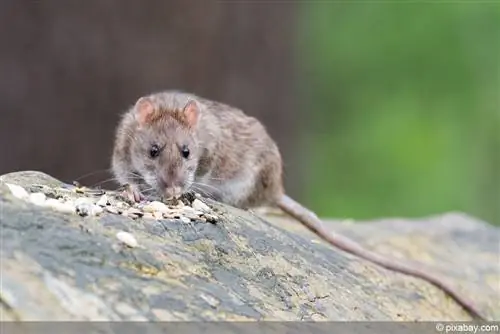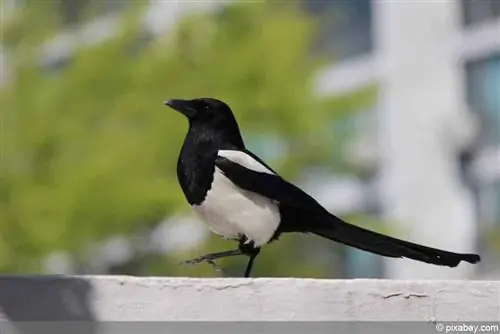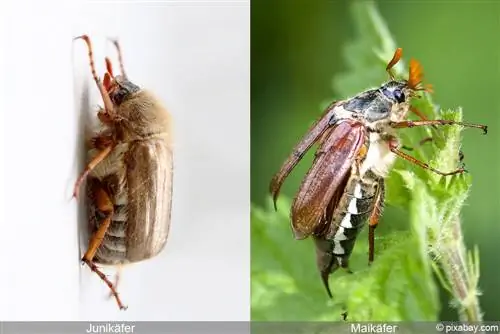- Author admin [email protected].
- Public 2023-12-17 03:39.
- Last modified 2025-01-24 12:45.
As absurd as it sounds: If suspicious crumbs etc. indicate that the rat population in the area is reaching unpleasant proportions/is moving too close to the home environment, it is time to take a look at the rodents' remains. But not up close (just not!), and please without any contact, the brief inspection only helps to assess the extent of the infestation and to select the measures to be taken. Most of the time, nothing more than simple cleaning/tidying up is required, first of all to put your mind at ease: you don't need to be afraid of rats or infection if you remove the residue hygienically and correctly.
All clear and warning
The “normal rat infestation” is limited to the natural house environment, in which rats “occur more often”: An estimated 160 to 200 million rats live in Germany, at least twice as many as human inhabitants. Occasionally a rat gets lost in adjoining rooms or living rooms and then leaves some droppings there because these animals often lose something. In rare cases, a family of rats wants to settle in rooms and has to be informed of the unsuitable location by noise and commotion; everything is more like hygiene problems.
But because “things from someone else's intestines” are serious hygiene problems and can, in rare cases, be contagious, you should definitely be careful not to come close to the excrement. Avoid getting too close so that you don't run the risk of inhaling dust that might have come into contact with the excrement, which would pose the risk of infection (you'll find out how to clean the presents safely in a moment).
Rat droppings: appearance, size, smell
In order to be able to judge whether brown crumbs that appear unexpectedly are actually crumbs or “toilet remains” from rats/other small animals, you as a home and garden owner should know which small animal leaves what in the area distributed". If the prospect of really disgusting descriptions of amorphous brown masses is already sending shivers down your spine:
This shower is allowed to pass; a description follows that is limited to the scientific and hygienic aspects. Because, for hygienic reasons, you shouldn't get close enough to the visual and olfactory side of the matter to be able to accurately assess the size, appearance and smell, the disgust factor tends to be zero (still, not exactly the most sensitive member of the household should be tasked with inspecting the brown crumbs):
Of 65 species of rats, most live in Southeast Asia and only a few as cultural followers in human proximity, of which only the domestic rat (Rattus rattus) and the brown rat (Rattus norvegicus) in our area, animals and feces can be recognized like this:
House Rat
Slim to rounded body 15-25 cm long, rather naked-looking tail of 18-28 cm, always longer than the head-torso measurement. Grey-black, with brown-grey cover or brown-grey with white underside; smaller specimens can be confused with mice because of their round head with a pointed snout and large eyes and ears. Also known as the roof rat because of its preference for dry, high-lying parts of buildings, it is known as the ship rat because of its worldwide distribution as a stowaway on transport ships.
The excrement is characterized by the following characteristics:
- slightly curved “sausages”
- first light to medium brown, later darker
- Length 1-2 cm
- are more likely to be scattered around the area
Is currently on the Red List of Endangered Species because, like red squirrels, it is being replaced by a more robust species:
Black Rat
Body 20-30 cm, short thick bristle tail of 13-23 cm, always shorter than the body. Slender but strongly built, rather square skull with a blunt snout and small round ears. The color of the fur varies from brown-gray to light brown, fox red to brown-black, the tail is two-colored, gray-brown above, lighter below. Because of their rich pigmentation, colored rats were bred from brown rats, which today are no longer just kept as pets and loved by punks.
Black rats prefer to live on the edges of water from the sea coast to the garden pond and in cold areas they like to move into damp burrows that are rarely visited by people (but only if there is water nearby, otherwise they are more likely to end up in the sewer because of this). Preference for moisture close to the ground, they are also known as sewer rats or cellar rats).
Your poop looks like this:
- small thick cocoons
- rather wide and quite black
- usually slightly larger than the rat's solution, ∅ 2-3 cm
- more like gathered in a heap
Other cellar and attic visitors In addition to rats, other animals have developed into cultural followers or, due to a lack of other habitats, are discovering cities and towns for themselves. The capital's residents share Berlin (which is also a city with a lot of greenery) with a good 50 species of mammals and 180 different birds. Some of them accidentally get lost in rooms, others want to move into a heated apartment, others are temporarily looking for a cozy baby station. You can look at a “special kind of poster” to see “who” and “what” with you could have left behind: www.laves.niedersachsen.de/tiere/schaedlingsbekaempfung/diagnostik/ziel-smaller-viertiere-anhand-ihrer-losung-73481.html.
Ammonia smell
comes into play wherever small animals have created solid urine-marked bladders (or have simply emptied well-filled bladders). The strong, pungent smell of ammonia arises during the bacterial decomposition of urine, when bacteria use the enzyme urease to break down urea into ammonia and carbon dioxide. Even if some articles on the subject give the impression that it is not rat-specific, but could just as easily have been caused by human drunkards - the smell of ammonia doesn't tell you anything other than that someone has peed there at some point (fresh urine doesn't smell, Ammonia only occurs after a long time).

Disclosure
If you really want to know exactly which animal it is, you have two options:
- If traces of urine glow under UV light, they can only come from mice or rats
- Over the course of evolution, only rodents have managed to extend their sense of vision to the UV reflections of their urine
- The news of the discovery of the “visible scent traces”: www.mpg.de/475504/pressemitigung20030610
- UV light flashlights are available to buy
- Under the above “Poster address” you will find a form for sending in the password, which will be determined for a small fee
Tip:
Usually you will find legacies in the garden. Cleaning once and perhaps tidying up a little is often enough to teach the rats discretion when going to the toilet in the future (they retreat to the outer boundaries of the property). There, the dirt or dirt, as the Austrians so aptly call the rat droppings, has a lot of positive things for the garden - the composition is comparable to the guano fertilizer, which some garden owners spend a lot of money on. In other words: Manure is manure, whether from rodents or birds or cows, previously collected in so-called gold buckets and sold to fertilizer factories, full of minerals and undigested components from which the next workers in the processing chain (molds, mites and… Co.) Make soil. The rats themselves also have their tasks in our environment; no capital city resident wants e.g. B. really know what Berlin would look like if 2.2 million rats and 49 other mammals didn't help the (probably because of this notoriously good-humored) city cleaning service to remove the "free-roaming garbage" of 3.5 million residents.
Identification of legacies is not necessary for private individuals; In the case of a light infestation, hygienic conditions can be restored even without knowledge of the species causing the problem; in the case of a severe infestation, a pest controller must be hired anyway, as controlling rats with poison is no longer a private matter these days. Before you make the decision “cleaning or calling the pest controller”, here is an overview of the current risk situation:
Threat Assessment
Rats as disease vectors
In every article about rats you can read that wild rats are dangerous because of disease transmission, often (because of the same old source?) 70 diseases are mentioned. In reality, there have been around 250 zoonoses (that's what scientists call diseases transmitted through animals, see www.fu-berlin.de/presse/publikationen/fundiert/archiv/2011_01/04_querfurth/index.html) since 2011, and rodents are one of them Europe is one of the important vectors.
You can find out which of these zoonoses are currently being monitored in more detail in Germany by looking at the Infection Protection Act (IfSG), any additional regulations to adapt the reporting requirements, the current zoonoses monitoring of the Federal Office for Consumer Protection and Food Safety and the current status adapted information from the Federal Office for Risk Assessment (www.bfr.bund.de/de/zoonosen.html).
Rats, mice and other rodents can transmit some diseases, salmonella and leptospirosis and the hantavirus and, as vectors, ticks with Borrelia; but are pretty far down on the list of statistically noticeable disease vectors - here is an overview of the worldwide distribution of the hantavirus (which is fatal in less than 1% of cases), which in our country is more likely to be transmitted to hunters, farmers and forestry workers by forest voles.

The Free University of Berlin does not mention rodents at all in the above-mentioned information on nationwide zoonoses projects, they are so insignificant compared to zoonoses that you can pick up in the kitchen, on a walk or in contact with pets. Our state is doing a lot to combat this, for example the 190,000 salmonella infections in the early 1990s. B. pushed back to 25,000 by 2010.
There is no risk of infection from rodents if hygienic conditions are quickly and comprehensively restored in the affected area. If rats and mice become a problem somewhere, the state takes action (see, for example, Section 18 of the Infection Protection Act, officially ordered disinfection, disinfestation, combating vertebrates that transmit pathogens), including requiring citizens to report, so that cross-regional control measures can be initiated if necessary can be.
The danger for citizens lurks elsewhere, in factory farming (well-kept animals have less stress and are less susceptible to pathogens), in the egg from the shoebox chicken farm and, last but not least, in the poorly paid employee of a “parasitic foodstuff”. -Company” who, despite signs of illness, does not dare to stay at home because otherwise he would lose his job. If you buy more from the small organic retailers that are popping up everywhere, you will not only have a clear conscience and make your diet tastier, but you will also be doing something against the spread of zoonoses. Which doesn't mean that "increased rat numbers" can be ignored:
Rats as hygiene and food pests
Rodents are allowed to live in peace around human settlements if there is no sign of them. If they become too many or even invade rooms, all food supplies that can be nibbled quickly suffer. Reason enough to take immediate action against the rodents - it's always amazing what you can nibble on when, like a rat, you rely on the wear and tear of your nail teeth (which would otherwise grow beyond your hind legs, really unpleasant).
Hygiene definitely suffers when there are too many rodents or they invade rooms because these little animals eat relatively large amounts of food and therefore dispose of leftovers relatively often. And these remains, the scientifically known feces or faeces (faeces), contain not only unabsorbed food components, intestinal mucosa cells, digestive secretions and water, but also various fermentation and putrefaction products and intestinal bacteria in large quantities.
Foreign intestinal bacteria are part of the daily immune training of people who live with many animals and cannot be easily knocked down by anything (not even by salmonella or hantaviruses, because they know the danger and symptoms and, when in doubt, go to the doctor quickly); However, for the city dweller who is far from nature and has perhaps driven his immune system into agony with Sagrodings and the like, contact can become a real challenge. So next it says:
Assess infestation intensity
Rats not only leave behind solid, brown solution, but also some other traces:
- Walking paths, like human trails, only much narrower
- On smooth or textile surfaces indoors there may be traces of smear or grease
- Fresh feces are soft and shiny, older feces are dry and crumbly
- Even traces of mold take a while to develop
- Assess both signs from a distance before putting on protective clothing
- The already mentioned smell of ammonia comes from older urine
- Naw marks (make the visit last if there is still something to be picked up from gnawed packaging)
There have to be a lot of traces in the garden before an assessment of the intensity of the infestation is possible - this usually makes it unnecessary because the he alth authority has long been working on preventing the rats from entering the area as part of a comprehensive control measure to take over.
If you can't judge with certainty whether a rat has passed by or whether a rat wellness resort with branches is currently forming in your area, you can initially stick to the following measures: Dusty walkways/areas with rat droppings first moisten and then clean, combat the smell of ammonia with odorous plant manure (well-fermented nettle, garlic-onion decoction), remove rat attractions such as garbage heaps.

Searching for clues
If that's not enough, it's time to look for clues; based on what attracts rats (dirt got into stacked garden furniture, an animal died in a pile of dead wood, fake food leftovers in the compost).
Authorities
If that's not enough, it's time to contact the local he alth department because it could be a property-wide infestation. If this is not the case, you will also receive tips on how best to proceed in a given situation; As a rule, a professional pest controller must be hired.
Hygiene
If the rats have penetrated rooms, the same considerations must be made, but the protective and precautionary measures recommended when the hygienic condition is restored must be observed even more carefully:
Removal of feces and odor
If it's just a matter of removing the remains of rodents that have migrated further, you can and must take action yourself. Maintaining hygiene is one of the homeowner's duties; in many places, pest control regulations describe the desired hygiene level in more detail.
The following protective and precautionary measures must be observed when cleaning/tidying up/disposing of waste:
- Avoid contact with excrement and inhalation of contaminated dust
- Before cleaning, put on boilable clothing, a dust mask and sturdy disposable gloves
- After each contact with “disgusting mass”, dispose of gloves with the outside inwards and keep others ready
- Remove rubbish, junk, stuff
- Venter rooms well, then lightly moisten dusty deposits
- Clean rooms with slow movements
- Only use work equipment that can be easily disinfected: broom, shovel versus a complicated vacuum cleaner
- Collect textiles in garbage bags and put them in the washing machine, using the boil cycle
- Disinfect surfaces, allow disinfectant to take effect according to package instructions
- Then disinfect the work equipment
- Take off your work clothes into a blue garbage bag and boil it
- Finally, disinfect your shoes and shower thoroughly, also washing your hair for a long time
If you handle all of this as if every contact “with the stuff” never leaves removable red marks, you will also be able to clean a fecal colony full of hantaviruses without any consequences. It takes a lot of concentration for people who are not professionally trained in hygiene, but it is doable. If you keep the “room that now shines with cleanliness” in approximately this condition in the future, making sure that the house sewer system is intact, the garbage cans are closed and the cellar windows are closed, it will certainly be the last rodent visit.
Conclusion
Once again, it's very clear: combating rats with poison is the responsibility of the community/pest controller. Private individuals may be able to buy illegal rat poison on the Internet, but they are not allowed to use it (www.planet-wissen.de/natur/haustiere/ratten/ratten-rattenwissen-100.html).






